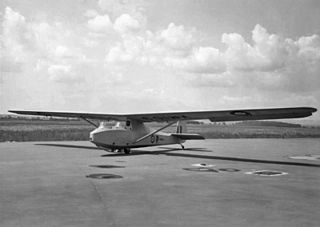Related Research Articles
The Slingsby Type 26 Kite 2 was a post World War II development of the Slingsby Kite, a single seat medium performance sailplane. It sold in small numbers.

The Slingsby T.24 Falcon 4 was a two-seat training glider designed in the UK just after World War II for ATC use. It was judged too expensive for production and only three were completed.

The Handasyde glider was a single-seat monoplane glider, designed specifically for the first British gliding competition held at Itford Hill in 1922, an endurance event. It finished in second place to a French tandem-wing machine.
The Gordon England glider was a single seat glider designed specifically for the first British gliding competition held at Itford Hill in 1922, an endurance event. It made some competition flights but was damaged on the last day.
The Sayers S.C.W. was a single seat monoplane glider, designed specifically for the first British gliding competition held at Itford Hill in 1922, an endurance event. Unresolved control problems stopped it from making any competitive flights, but it flew successfully later in the year. It was destroyed on the ground by a storm in December 1922.
The Merriam glider was a single-seat monoplane glider, designed specifically for the first British gliding competition held at Itford Hill in 1922, an endurance event. It crashed at the start of its first competitive flight but went on to be converted into a dual control training glider.
The Peyret Tandem or Peyret Alérion, was a French single seat glider of tandem wing configuration. It won first prize at the first British Glider Competition of 1922.

The Abbott-Baynes Scud 1 was a parasol-winged single seat glider intended to introduce pilots to soaring flight. It was built in the United Kingdom and first flew in 1931.

The Abbott-Baynes Scud 2 was a 1930s high-performance sailplane, built in the UK. It was a development of the intermediate-level Scud 1 with a new, high aspect ratio wing.
The Addyman Zephyr was a one-off, single-seat sailplane designed and built by Erik Addyman in the UK for his own use in the 1930s.
The Dart Totternhoe was a single seat secondary training glider produced in the United Kingdom in the 1930s. Three were built, one serving in the RAF.
The Davis-Costin Condor was a conventional all-wood, tandem-seat sailplane built in the United Kingdom in the 1950s. Only one was constructed; it was later rebuilt with a longer fuselage and other detailed alterations as the Condor 2.
The Penrose Pegasus was a 1930s high-wing, single-seat, wooden glider from the UK. Designed, built and flown by Harald Penrose until the start of World War II, only one was built at the time though a reproduction was constructed in the 1990s.
The Radlock Trainer was a single seat primary glider designed and built by members of the Hull Experimental Gliding Club as a basic trainer for their own use in the early 1930s. It was a simple, single exposed seat, wooden glider with a parasol wing.
The Reynard R.4 Primary was an open seat primary glider with an open girder fuselage and a high, wire braced wing. It was designed and built in the UK in 1930 and a few served Gliding Clubs in England and Ireland.
The Stedman TS-1 City of Leeds was a parasol wing wooden sailplane, seating two in tandem open cockpits. Only one was built, by its designer in 1934; it remained active until the outbreak of World War II.
The Caproni Vizzola MF and 2 were single-seat gliders built in Italy just before world War II. Intended as training aircraft capable of aerobatics, the two variants differed only in their fuselages. Only one of each was built, but they were both successful in Italian competitions.
The DTGL Sant' Ambrogio was an Italian single seat glider, designed and built by a 19-year-old model aircraft enthusiast, that competed in the 1938 national championships. Four more were constructed from his plans.

The RRG Falke of 1930 was a secondary training glider designed by Alexander Lippisch in Germany and intended to provide better performance than his earlier RRG Prüfling whilst being easier to fly because of its inherent stability. It was sold as plans for both club and commercial production and was built in Germany and abroad.

The Grüne Post was a secondary trainer glider designed by Alexander Lippisch at the request of a German newspaper, the Grüne Post, who distributed plans. Many were built by amateur groups.
References
- ↑ Ellison, Norman (1971). British Gliders and Sailplanes. London: A & C Black Ltd. p. 16. ISBN 978-0-7136-1189-2.
- ↑ "Gliding Competition". Flight . No. 28 September 1922. p. 559.
- 1 2 3 4 Ellison 1971, p. 70
- 1 2 "The British Gliding Competition". Flight . No. 19 October 1922. pp. 607, 612.
- 1 2 "The British Gliding Competition". Flight . No. 26 October 1922. pp. 626, 629.